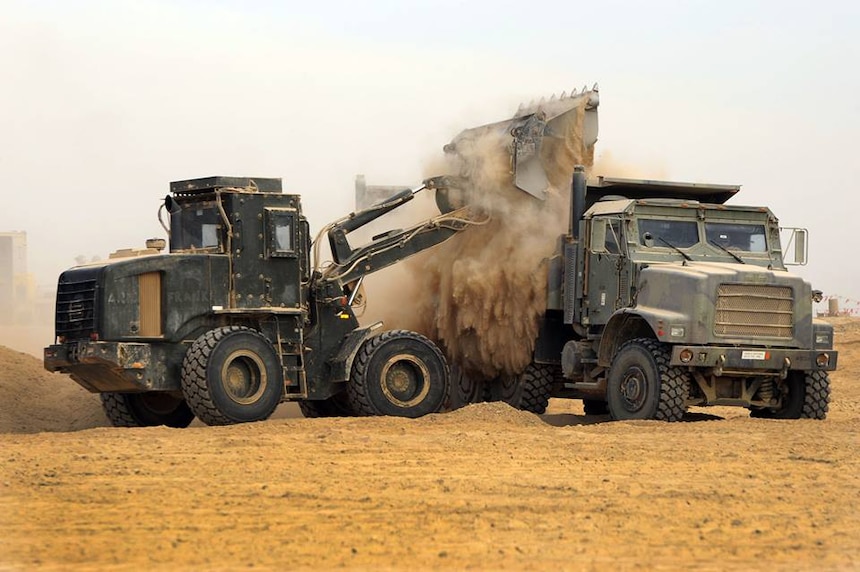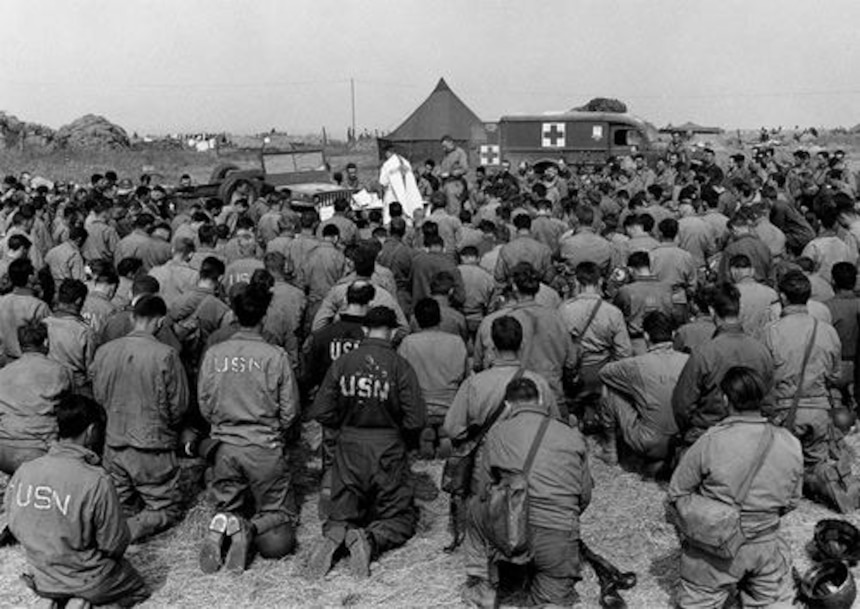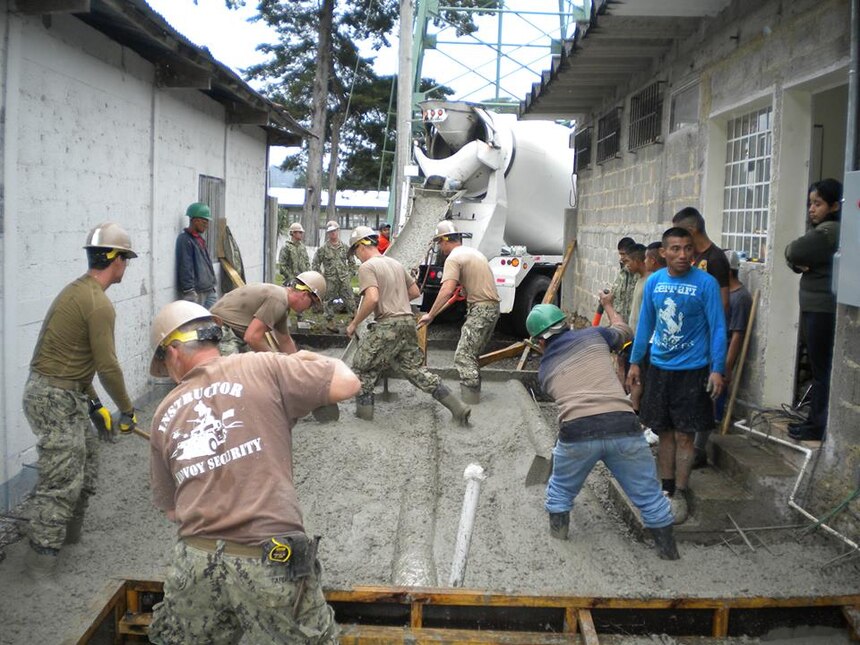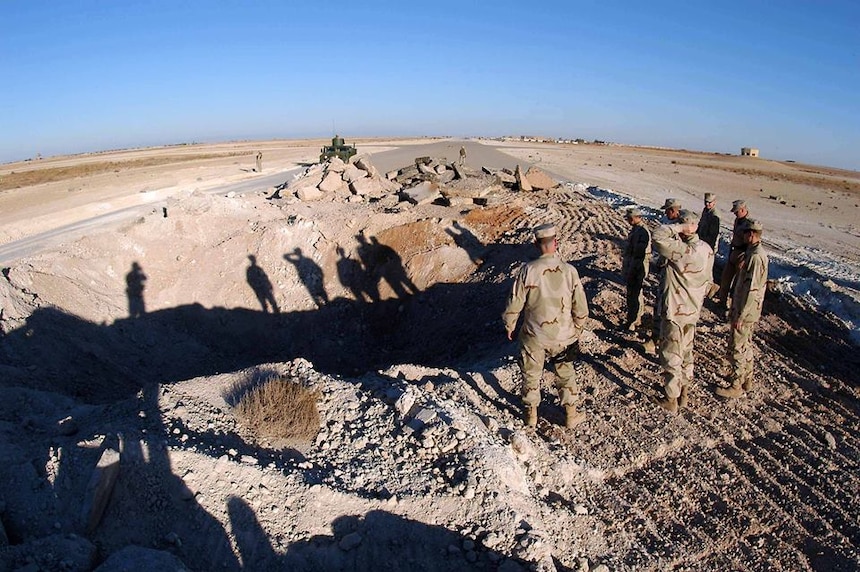Consolidated By U.S. Navy Seabee Museum, Naval History and Heritage Command
November 20
1943: 18th Special (Naval Construction Battalion (NCB) commissioned at Naval Construction Training Center (NCTC) Camp Peary, Magruder, Virginia.
Nov. 20-28, 1943: During World War II, the island campaign of the Central Pacific began. Tarawa, Makin and Apamama in the Gilbert Islands fell between Nov. 20-28. The toughest objective was the fortress of Betio, main island of the Tarawa Atoll. A savage air and naval bombardment razed the above-ground defenses, but the well dug in Japanese defenders took a toll of nearly 1,000 American dead in one of the costliest island seizures of the Pacific War. D-Day plus 4 saw the first echelons of the 74th and 98th NCBs come ashore at Tarawa. The big problem was cleaning up ravaged Betio Island. As a base, it has been wrecked. Ruins, decaying food dumps, thousands of dead from both sides and chaos met the occupiers. The Seabees had to clear and grade virtually every square foot of the island, and put Tarawa s Japanese airstrip in use less than a day after landing. Keeping it in continuous operation, they resurfaced and lengthened the runway to 6,000 feet. In addition, they erected a fuel farm and housing facilities, and inventive Seabees used Japanese materials to rebuild Tarawa s principal dock.
1945: 19th Naval Construction Regiment (NCR) inactivated. 88th NCB inactivated at Samar, Philippines. 94th and 128th NCBs inactivated on Guam.
1956: The Seabees had long been used to working tropical jungles and even in the extreme cold of Alaska, but Operation Deep Freeze took them to the coldest and most desolate area on earth. On November 20, eight Seabees and 11 dogs were landed by plane near the geographical South Pole to begin construction of South Pole Station, the first permanent camp at the South Pole. Thanks to the Seabees, Antarctica was later able to boast snow-compacted roads and runways, underground storage and comfortable living areas. Read Rendezvous with Penguins: Seabee Construction of the South Pole Dome on SEABEE Online.
1966: Naval Mobile Construction Battalion (NMCB) 62 s advance party of 6 officers and 109 men arrived at Phu Bai, RVN, to begin the Battalion Equipment Evaluation Program (BEEP) and prepare to relieve NMCB 7.

November 21
1945: 21st NCB inactivated on Okinawa.
1965: NMCB 9 named its camp in honor of Steward 3rd Class Restituto P. Adenir, who was the first member of NMCB 9 killed in Vietnam (October 28, 1965).
1967: Chief of Naval Operations (CNO) requests that the Commander, Naval Facilities Engineering Command (NAVFAC) be advised by naval commands and project offices engaged in oceanographic and deep sea development and/or operational activities for which facility/construction requirements may be generated or required of program developments on a continuing basis in order that the advancements in NAVFAC and Seabee underwater construction capabilities are matched to emerging operational requirements.
November 22
1960: During the summer, an unusual rainfall caused Lake Miragoane, near Mira, Haiti, to rise and virtually isolate the southern tip of Haiti. Haitian Army engineers called on the United States to help. A Seabee detachment from Amphibious Construction Battalion (ACB) 2 was sent to the area. The detachment constructed a bridge and improved six miles of road leading to it. On November 22, the bridge and road were dedicated. The dedication ceremonies were attended by the U.S. ambassador to Haiti and numerous Haitian government officials. 1969: NMCB 121 relieved NMCB 8 on board Camp Haskins South, Da Nang, Republic of Vietnam (RVN). Nov. 22-26, 1969: NMCB 8 main body deployed from Camp Haskins South, Da Nang, RVN, to Construction Battalion Center (CBC), Port Hueneme, California. 1971: NMCB 5 completed its deployment to the Western Pacific (WESTPAC).
November 23
1942: 39th NCB commissioned in Norfolk, Virginia (exact location unknown). 1943: ACORN 14 and ACORN 17 arrived at Tarawa. (In World War II, Navy ACORN units, composed of Seabees and other components such as aircraft maintenance units, etc., were put together to design, construct, operate and maintain forward landplane and seaplane bases and operational facilities.) 1943: ACORN 16 arrives at Apamama Atoll, in the Gilbert Islands, Kiribati. 1945: 45th and 53rd NCRs inactivated. 148th NCB inactivated on Okinawa. 12th Special NCB inactivated at Okinawa. 1965: Advance party of NMCB 4 arrived at Camp Shields, Chu Lai, RVN.

111 NCB Normandy, France on Thanksgiving. (Courtesy of U.S. Navy Seabee Museum)
November 24
1944: The necessity of building an airstrip on Samar Island in the Philippines became evident even before American forces landed there, so three Seabees and a geologist were landed to make a survey under the very noses of the Japanese. Led by Cmdr. Bradford Bowker, officer in charge (OIC), NCB 61, the group boarded a Landing Craft, Mechanized (LCM) on the night of Nov. 23, and silently stole ashore the following morning. Any thought of a secret landing was dispelled, however, as the small group reached shore. There, 5,000 cheering Filipinos stood to greet them. Instead of a sneak survey, the adventure turned into a wild party of eating, drinking and dancing. It seems that Bowker, a tall man with a hawk-like profile, was mistaken by the natives for Gen. Douglas MacArthur and nothing the commander could say convinced them otherwise. The next day, the secret survey was made and three days later the Seabees left the island with the location of the future airstrip determined.
1945: 44th NCR inactivated. 17th NCB inactivated and personnel transferred to 58th NCB on Okinawa. 101st NCB inactivated on Okinawa.
1967: Second increment of NMCB 58 s advance party arrived at Da Nang, RVN.
1992: The U.S. formally turned over the naval installations at Subic Bay and Cubi Point to the Republic of the Philippines, ending almost half a century of Seabee construction and maintenance at both installations. [caption id="attachment_17525" align="alignnone" width="748"]
 2012:
2012: Seabees from Naval Mobile Construction Battalion (NMCB) 27 and peacekeepers at the CREOMPAZ military base in Coban, Guatemala poured a concrete pad as part of a renovation project in support of U.S. Southern Command's Global Peacekeeping Operations Initiative. The Seabees from NMCB 27 were forward deployed throughout South and Central America in support of U.S. Naval Forces Southern Command and U.S. 4th Fleet peacekeeping, multinational partnership, and humanitarian assistance missions. (Courtesy of U.S. Navy Seabee Museum)
November 25
1944: ACORN 35 decommissioned. [caption id="attachment_17537" align="alignnone" width="745"]
 2004:
2004: Commander, Naval Reserve Force, Vice Adm. John G. Cotton viewed a Seabee project at the Al Asad airfield in western Iraq. Reserve Seabees assigned to Naval Mobile Construction Battalion Two Three (NMCB-23) took on this extensive project, which included making permanent repairs to 39 swimming pool-size impact craters on different sections of the airfields runways. The craters, a result of bombing during the 2003 invasion of Iraq, left the airfield inoperable for more than a year. Vice Adm. Cotton was in Iraq over the Thanksgiving holiday to meet with mobilized Navy reservists deployed to the region. (Courtesy of U.S. Navy Seabee Museum)
November 26
1942: On this date, Camp Parks was established near Shoemaker, California. Although originally established as a replacement and recuperation center for Seabee battalions returning from overseas, in practice the major service rendered at Camp Parks was the tactical training of Seabee units transferred from the east coast for embarkation to the war zone. Incidentally, Camp Parks was called upon from time to time to provide all phases of primary military and technical training for Seabee units. 1944: Construction Battalion Maintenance Unit (CBMU) 629 played an instrumental role in breaking Germany s formidable Rhine River barrier. The U.S. Army, concerned about the river s swift and tricky currents, called upon the Seabees to construct, operate and train their personnel in the operation of landing barges that would be used to carry assault forces into the enemy s homeland. Thus it was that CBMU 629 became the first Seabee unit to enter Germany on Nov. 26. 41st Special NCB formed at Hollandia. 1945: 17th NCR inactivated. 127th NCB inactivated at Leyte Samar, Philippines. 136th NCB inactivated on Guam. 145th NCB inactivated on Okinawa. 28th Special NCB inactivated at Yokosuka, Japan.